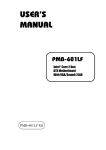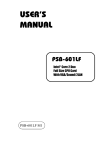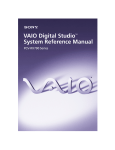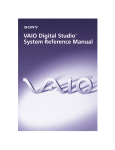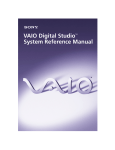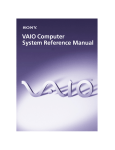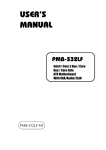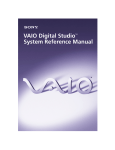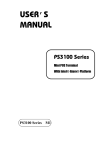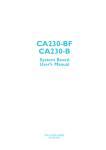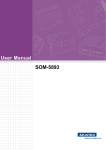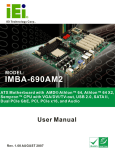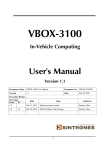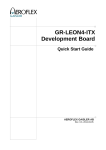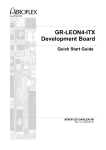Download site:de intitle:"user manual"
Transcript
USER’S MANUAL PMB-732LF Intel® Core 2 Duo ATX Motherboard With VGA/Audio/2LAN PMB-732LF M3 Copyright Notice PMB-732LF Intel® Core 2 Duo ATX Motherboard With VGA/ Sound/ 2LAN OPERATION MANUAL COPYRIGHT NOTICE This operation manual is meant to assist both Embedded Computer manufacturers and end users in installing and setting up the system. The information contained in this document is subject to change without any notice. This manual is copyrighted in August 2009. (Revised Edition: October 2010) You may not reproduce or transmit in any form or by any means, electronic, or mechanical, including photocopying and recording. ACKNOWLEDGEMENTS All trademarks and registered trademarks mentioned herein are the property of their respective owners. CE NOTICE This is a class A product. In a domestic environment this product may cause radio interference in which case the user may be required to take adequate measures. Copyright Notice FCC NOTICE This equipment has been tested and found to comply with the limits for a Class A digital device, pursuant to part 15 of the FCC Rules. These limits are designed to provide reasonable protection against harmful interference when the equipment is operated in a commercial environment. This equipment generates, uses, and can radiate radio frequency energy and, if not installed and used in accordance with the instruction manual, may cause harmful interference to radio communications. Operation of this equipment in a residential area is likely to cause harmful interference in which case the user will be required to correct the interference at his own expense. You are cautioned that any change or modifications to the equipment not expressly approve by the party responsible for compliance could void your authority to operate such equipment. Contents TABLE OF CONTENTS CHAPTER 1-1 1-2 1-3 1 INTRODUCTION About This Manual ........................................................ System Specification ...................................................... Safety Precautions ......................................................... CHAPTER 2 1-2 1-3 1-6 HARDWARE CONFIGURATION 2-1 Jumper & Connector Quick Reference Table ................ 2-2 Component Locations .................................................... 2-3 How to Set the Jumpers ................................................. 2-4 COM Port Connector ……..…………………………... 2-5 COM3 RI & Voltage Selection …………..……………. 2-6 COM4 RI & Voltage Selection ……………………… 2-7 RS232/422/485(COM2) Selection ................................ 2-8 COM2 Auto Detect Selection …………………………. 2-9 FSB Frequency Selection ……………………………… 2-10 LVDS Voltage Selection ……………………………… 2-11 TV Out Connector …………………………………….. 2-12 Keyboard and PS/2 Mouse Connector .....................….. 2-13 Reset Connector .............................................................. 2-14 Hard Disk Drive LED Connector ................................... 2-15 ATX Power Button ……………………………………. 2-16 External Speaker Connector ........................................... 2-17 PLED Connector ………………………………………. 2-18 Sleep Connector ……………………………………….. 2-19 Clear CMOS Data Selection ………………………… 2-20 CPU Fan Connector …………………………………… 2-21 System Fan Connector ………………………………… 2-22 TPM Connector ………………………………………... 2-23 VGA Connector …………………..…………………… 2-24 Serial ATA Connector ………………………………… 2-25 Floppy Disk Drive Connector ....................................... 2-26 Printer Connector .......................................................... 2-27 Universal Serial Bus Connector ……………………… 2-28 IrDA Connector ………………………………………. 2-29 USB & LAN Connector ……………………………… 2-30 LVCD Connector ……………………………………… 2-31 Inverter Connector …………………………………….. 2-32 Digital Input/Output Connector ……………………….. 2-28 ATX Power Connector ………………………………. 2-2 2-3 2-4 2-6 2-8 2-9 2-10 2-11 2-12 2-13 2-14 2-15 2-15 2-16 2-16 2-16 2-17 2-17 2-18 2-18 2-19 2-19 2-20 2-21 2-23 2-24 2-25 2-26 2-27 2-29 2-29 2-30 2-31 Contents 2-29 2-30 2-31 Sound Connector ……………………………………… CD Audio-In Connector ………………………………. Memory Installation ………………………………….. CHAPTER 3-1 3-2 3-3 3-4 3-5 3-6 3-7 SOFTWARE UTILITIES Introduction …………..........................................…....... VGA Driver Utility ……………………………….…… Flash BIOS Update ..............................................…....... LAN Driver Utility …...........................................…...... Sound Driver Utility …………………………………… Intel Chipset Software Installation Utility …..……..….. Watchdog Timer Configuration ……………………….. CHAPTER 4-1 4-2 4-3 4-4 4-5 4-6 4-7 4-8 4-9 4-10 4-11 4-12 4-13 4-14 3 4 A 3-2 3-3 3-4 3-6 3-7 3-8 3-9 AWARD BIOS SETUP Introduction ................................................................... Entering Setup ............................................................... The Standard CMOS Features ………............................ The Advanced BIOS Features ....................................... Advanced Chipset Features ........................................... Integrated Peripherals …............................................... Power Management Setup ............................................. PNP/PCI Configuration …............................................. PC Health Status …….................................................... Load Fail-Safe Defaults ................................................. Load Optimized Defaults .........................................…. Password Setting ……………………………………… Save & Exit Setup ......................................................... Exit Without Saving ………………………………… APPENDIX 2-32 2-33 2-33 4-2 4-3 4-4 4-7 4-10 4-12 4-19 4-20 4-21 4-22 4-22 4-23 4-24 4-25 EXPANSION BUS PCI Bus Pin Assignment ..............................................…......... A-2 APPENDIX B TECHNICAL SUMMARY Block Diagram ........................................................................... Interrupt Map ............................................................................ DMA Channels Map ................................................................ I/O Map .................................................................................... Memory Map .........................................................…................ B-2 B-3 B-4 B-4 B-7 CHAPTER INTRODUCTION 1 This chapter gives you the information for PMB-732LF. It also outlines the System specifications. Section includes: About This Manual System Specifications Safety Precautions Experienced users can skip to chapter 2 on page 2-1 for a Quick Start. Page:1-1 Chapter 1 Introduction 1-1. ABOUT THIS MANUAL Thank you for purchasing our PMB-732LF Intel® Core 2 Duo ATX Motherboard enhanced with VGA/Sound/2LAN, which is fully PC / AT compatible. The PMB-732LF provides faster processing speed, greater expandability and can handle more tasks than before. This manual is designed to assist you how to install and set up the system. It contains four chapters. The user can apply this manual for configuration according to the following chapters: Chapter 1 Introduction This chapter introduces you to the background of this manual, and the specifications for this system. The final page of this chapter will indicate how to avoid damaging this board. Chapter 2 Hardware Configuration This chapter outlines the component locations and their functions. In the end of this chapter, you will learn how to set jumper and how to configure this card to meet your own needs. Chapter 3 Software Utilities This chapter contains helpful information for proper installations of the VGA utility, LAN utility, Sound utility, and Flash BIOS Update. It also describes the Watchdog-timer configuration. Chapter 4 Award BIOS Setup This chapter indicates you how to set up the BIOS configurations. Appendix A Expansion Bus This Appendix introduces you the expansion bus for 4 x PCI BUS, 2 x PCI-E 4x BUS, 1 x PCI-E 16x Bus. Appendix B Technical Summary This section gives you the information about the Technical maps. Page: 1-2 PMB-732LF USER′S MANUAL Chapter 1 Introduction 1-2. SYSTEM SPECIFICATIONS CPU: Intel® Penryn CPU / Sock478-pin socket on board Intel® Core™ 2 Duo processor Intel® Celeron® M. (Support Intel 45nm Penryn CPU) CHIPSET: Intel GM45 + ICH9M / ICH9M-E +SPI (FSB: 667/1066MHz) MEMORY: 2×200Pin DDR2 SO-DIMM to support 667/800MHz. BIOS: Phoenix Award PnP BIOS with 32MB size flash, with VGA BIOS. KEYBOARD CONNECTOR: PS/2 Connector, with mini DIN connector on Rear Panel. MOUSE CONNECTOR: PS/2 Connector, with mini DIN connector on Rear Panel. BUS SUPPORT: 4×PCI, 2×PCI-E 4x, 1×PCI-E 16x DISPLAY: Build-in GM45 Support VGA, LVDS, TV-out Support SDVO (ADD2 & ADD2+) Support PCI-E 16x (Graphics Card) SATA INTERFACE: 4 ports S-ATA connector form ICH9M (support SATA DOM×1) SERIAL PORT: 4 ports. COM1/3/4 for RS-232,COM2 for RS-232/422/485. COM 3/4 can output +5V or +12V, and use Jumper settings. USB CONNECTOR: Support up to ten USB 2.0 ports. PMB-732LF USER′S MANUAL Page: 1-3 Chapter 1 Introduction LAN ADAPTER: Dual Ports to support 100/1000Mbps Lan1 : Intel 82567LM ×1 / Lan2 : Intel 82573V ×1 Supports Wake-on-LAN SOUND: High Definition Audio;Realtek ALC888, support SPDIF HARDWARE MONITORING FUNCTION: SIO IRDA PORT: One IrDA Port;Support v1.0 SIR protocol. PARALLEL PORT: 1 port, Bi-direction, SPP / EPP / ECP LED INDICATOR: HDD LED, power LED. IO and OTHER: LPC (Winbond W83627UHG ) RTC: Build in South Bridge. FDD: One FDD connector with 34-pin Boxheader. EXTENDABLE FUNCTION: TPM. DIGITAL I/O: 8in / 8out. RAID FUNCTION: Support Raid 0,1;Build in South Bridge(ICH9M-E only). SPEAKER: Internal buzzer. Page: 1-4 PMB-732LF USER′S MANUAL Chapter 1 Introduction WATCHDOG: 1~255 Sec POWER SUPPLY: Support ATX 24pin DMA CONTROLLER: 82C37 x 2 DMA CHANNELS: 7 INTERRUPT CONTROLLERS: 82C59 x 2 INTERRUPT LEVELS: 15 TEMPERATURE: Operation temperature 0°~60°C, Storage temperature -40°~85°C. HUMIDITY: Operation humidity 20~95%, Storage humidity 20~95%. BOARD DIMENSIONS: 305mm x 244mm BOARD NET WEIGHT: 630gram. PMB-732LF USER′S MANUAL Page: 1-5 Chapter 1 Introduction 1-3. SAFETY PRECAUTIONS Follow the messages below to avoid your systems from damage: 1. Keep your system away from static electricity on all occasions. 2. Prevent electric shock. Don‘t touch any components of this card when the card is power-on. Always disconnect power when the system is not in use. 3. Disconnect power when you change any hardware devices. For instance, when you connect a jumper or install any cards, a surge of power may damage the electronic components or the whole system. Page: 1-6 PMB-732LF USER′S MANUAL HARDWARE CONFIGURATION CHAPTER 2 ** QUICK START ** Helpful information describes the jumper & connector settings, and component locations. Section includes: Jumper & Connector Quick Reference Table Component Locations Configuration and Jumper settings Connector’s Pin Assignments Page 2-1 Chapter 2 Hardware Configuration 2-1. JUMPER & CONNECTOR QUICK REFERENCE TABLE COM Port Connector ....................…..................……… ………………………………….. COM3 Port RI/Voltage Selection …………………….. COM4 Port RI/Voltage Selection ……………………... RS232/422/485 (COM2) Selection .....................……… Keyboard/Mouse Connector ..........….....……………… Reset Connector .........................…....................………. Hard Disk Drive LED Connector .......................………. ATX Power Button …………………………………….. External Speaker Connector ....…........................……… PLED Connector …………….…….…...............……… Sleep Button …………………………………………… Clear CMOS Data Selection …………………………… CPU Fan Connector …………………………………… System Fan Connector …………………………………. TPM Connector ………………………………………... VGA Connector ……………………………………….. Serial ATA Connector …………………………………. Floppy Disk Drive Connector ……..........………....…... Printer Connector …….....................……………......… Universal Serial Bus Connector …….....................…… IrDA Connector ……………………………………….. USB&LAN Connector …....................................……… ATX Power Connector ………………………………… Sound Connector ………………………….…………… CD Audio-In Connector ……………………………….. Memory Installation …………………………………… Reserved PIN …………………………………………... Page: 2-2 COM1, COM2 COM3, COM4 JP11 JP12 JP13 KB_MS1 JP18 (5, 7) JP18 (1, 3) JP18 (6, 8) JP18 (10, 12, 14, 16) JP18 (2, 4) JP18 (13, 15) JP13 CPU_FAN1 SYS_FAN1 JP12 VGA1 SATA1, SATA2, SATA3, SATA4 FDD1 LPT1 USB1, USB2, USB3 IR1 USB_LAN1, USB_LAN2 ATX_PWR1, ATX_PWR2 AUDIO1 CD_IN1 DIMM1, DIMM2 JP4, JP6, JP8, JP9, JP10, JP11, JP14, JP15, JP21 PMB-732LF USERS MANUAL Chapter 2 Hardware Configuration 2-2. COMPONENT LOCATIONS LB-732LF Connector, Jumper and Component locations PMB-732LF USERS MANUAL Page: 2-3 Chapter 2 Hardware Configuration 2-3. HOW TO SET THE JUMPERS You can configure your board by setting jumpers. Jumper is consists of two or three metal pins with a plastic base mounted on the card, and by using a small plastic "cap", Also known as the jumper cap (with a metal contact inside), you are able to connect the pins. So you can set-up your hardware configuration by "open" or "close" pins. The jumper can be combined into sets that called jumper blocks. When the jumpers are all in the block, you have to put them together to set up the hardware configuration. The figure below shows how this looks like. JUMPERS AND CAPS If a jumper has three pins (for examples, labelled PIN1, PIN2, and PIN3), You can connect PIN1 & PIN2 to create one setting by shorting. You can either connect PIN2 & PIN3 to create another setting. The same jumper diagrams are applied all through this manual. The figure below shows what the manual diagrams look and what they represent. Page: 2-4 PMB-732LF USERS MANUAL Chapter 2 Hardware Configuration JUMPER DIAGRAMS Jumper Cap looks like this 2 pin Jumper looks like this 3 pin Jumper looks like this Jumper Block looks like this JUMPER SETTINGS 2 pin Jumper close(enabled) Looks like this 1 1 3 pin Jumper 2-3 pin close(enabled) Looks like this 1 1 Jumper Block 1-2 pin close(enabled) Looks like this 1 2 PMB-732LF USERS MANUAL 1 2 Page: 2-5 Chapter 2 Hardware Configuration 2-4. COM PORT CONNECTOR COM1 : COM1 Connector COM1 is fixed as RS-232. The pin assignment is as follows : PIN 1 2 3 4 5 6 7 8 9 ASSIGNMENT COM1_DCD# COM1_RX COM1_TX COM1_DTR# GND COM1_DSR# COM1_RTS# COM1_CTS# COM1_RI# COM2 : COM2 Connector The COM2 is selectable as RS-232/422/485. The pin assignment is as follows : PIN 1 2 3 4 5 6 7 8 9 Page: 2-6 ASSIGNMENT RS-232 RS-422 RS-485 COM2_DCD# TXTXCOM2_RX TX+ TX+ COM2_TX RX+ RX+ COM2_DTR# RXRXGND GND GND COM2_DSR# RTSGND COM2_RTS# RTS+ GND COM2_CTS# CTS+ GND COM2_RI# CTSGND PMB-732LF USERS MANUAL Chapter 2 Hardware Configuration COM3 : COM3 Connector COM3 is fixed as RS-232. The pin assignment is as follows : PIN 1 2 3 4 5 6 7 8 9 ASSIGNMENT COM3_DCD# COM3_RX COM3_TX COM3_DTR# GND COM3_DSR# COM3_RTS# COM3_CTS# COM3_RI# COM4 : COM4 Connector COM4 is fixed as RS-232. The pin assignment is as follows : PIN 1 2 3 4 5 6 7 8 9 ASSIGNMENT COM4_DCD# COM4_RX COM4_TX COM4_DTR# GND COM4_DSR# COM4_RTS# COM4_CTS# COM4_RI# PMB-732LF USERS MANUAL Page: 2-7 Chapter 2 Hardware Configuration 2-5. COM3 RI & VOLTAGE SELECTION JP11 : COM3 RI & Voltage Selection The selections are as follows: SELECTION JUMPER SETTINGS 5V 5-6 12V 3-4 RI 1-2 JUMPER ILLUSTRATION ***Manufacturing Default -- RI. Page: 2-8 PMB-732LF USERS MANUAL Chapter 2 Hardware Configuration 2-6. COM4 RI & VOLTAGE SELECTION JP12 : COM4 RI & Voltage Selection The selections are as follows: SELECTION JUMPER SETTINGS 5V 5-6 12V 3-4 RI 1-2 JUMPER ILLUSTRATION ***Manufacturing Default -- RI. PMB-732LF USERS MANUAL Page: 2-9 Chapter 2 Hardware Configuration 2-7. RS232/422/485 (COM2) SELECTION JP17 : RS-232/422/485 (COM2) Selection This connector is used to set the COM2 function. The jumper settings are as follows : COM 2 Function Jumper Settings (pin closed) RS-232 All Open RS-422 1-2, 3-4, 9-10 RS-485 1-2, 5-6, 7-8 Jumper Illustrations *** Manufacturing default -- RS-232. Page: 2-10 PMB-732LF USERS MANUAL Chapter 2 Hardware Configuration 2-8. COM2 AUTO DETECT SELECTION JP16 : COM2 Auto Detect selection The selections are as follows: SELECTION JUMPER SETTINGS NORMAL 1-2 AUTO GATING 3-4 JUMPER ILLUSTRATION ***Manufacturing Default – Normal. PMB-732LF USERS MANUAL Page: 2-11 Chapter 2 Hardware Configuration 2-9. FSB FREQUENCY SELECTION JP1, JP2, JP3 :FSB Frequency Selection The selections are as follows: JUMPER SETTINGS FREQUENCY Auto JP1 JP2 JP3 1-2 1-2 1-2 OPEN 2-3 2-3 OPEN OPEN 2-3 2-3 OPEN 2-3 JUMPER ILLUSTRATION 1066MHz (266 MHz) 800MHz (200 MHz) 667MHz (166 MHz) ***Manufacturing Default – Auto. Page: 2-12 PMB-732LF USERS MANUAL Chapter 2 Hardware Configuration 2-10. LVDS VOLTAGE SELECTION JP5 : LVDS voltage selection The selections are as follows: SELECTION JUMPER SETTINGS 3.3V 1-3, 2-4 5V 3-5, 4-6 JUMPER ILLUSTRATION ***Manufacturing Default – 3.3V PMB-732LF USERS MANUAL Page: 2-13 Chapter 2 Hardware Configuration 2-11. TV OUT CONNECTOR JP7 : TV Out Connector The pin assignments are as follows : PIN 1 3 5 7 9 Page: 2-14 ASSIGNMENT DACB_L GND DACC_L DLIN1 DLINE3 PIN 2 4 6 8 10 ASSIGNMENT DACA_L GND NC DLIN2 NC PMB-732LF USERS MANUAL Chapter 2 Hardware Configuration 2-12. KEYBOARD AND PS/2 MOUSE CONNECTOR KB_MS1 : Keyboard and PS/2 Mouse Connector The pin assignments are as follows : PIN 1 2 3 4 5 6 7 8 9 10 11 12 ASSIGNMENT KBDATA NC GND VCC5 KBCLK NC MSDATA NC GND VCC5 MSCLK NC 2-13. RESET CONNECTOR JP18 (5, 7) : Reset Connector. The pin assignment is as follows : PIN 5 7 ASSIGNMENT GND RST_BTN PMB-732LF USERS MANUAL Page: 2-15 Chapter 2 Hardware Configuration 2-14. HARD DISK DRIVE LED CONNECTOR JP18 (1, 3) : Hard Disk Drive LED Connector The pin assignment is as follows : PIN 1 3 ASSIGNMENT HD_LED+ HD_LED- 2-15. ATX POWER BUTTON JP18 (6, 8) : ATX Power Button The pin assignment is as follows : PIN 6 8 ASSIGNMENT PWRBTNSW GND 2-16. EXTERNAL SPEAKER CONNECTOR JP18 (10, 12, 14, 16) : External Speaker Connector The pin assignment is as follows : PIN 10 12 14 16 Page: 2-16 ASSIGNMENT SPK_VCC SPEAKER SIGNAL SPEAKER SIGNAL SPEAKER SIGNAL PMB-732LF USERS MANUAL Chapter 2 Hardware Configuration 2-17. PLED CONNECTOR JP18 (2, 4) : PLED Connector The pin assignment is as follows: PIN 2 4 ASSIGNMENT PW_LED+ PW_LED- 2-18. SLEEP BUTTON CONNECTOR JP18 (13, 15) : Sleep Button Connector The pin assignment is as follows: PIN 13 15 ASSIGNMENT SLP_BTN GND PMB-732LF USERS MANUAL Page: 2-17 Chapter 2 Hardware Configuration 2-19. CLEAR CMOS DATA SELECTION JP13 : Clear CMOS Data Selection The selections are as follows : FUNCTION JUMPER SETTING (pin closed) Normal Open Clear CMOS Close JUMPER ILLUSTRATION *** Manufacturing Default -- Normal. Note: To clear CMOS data, user must power-off the computer and set the jumper to “Clear CMOS” as illustrated above. After five to six seconds, set the jumper back to “Normal” and power-on the computer. 2-20. CPU FAN CONNECTOR CPU_FAN1 : CPU Fan connector The pin assignment is as follows: PIN 1 2 3 Page: 2-18 ASSIGNMENT GND VCC12 LPC1_FANIO1 PMB-732LF USERS MANUAL Chapter 2 Hardware Configuration 2-21. SYSTEM FAN CONNECTOR SYS_FAN1 : System Fan connector The pin assignment is as follows: PIN 1 2 3 ASSIGNMENT GND VCC12 LPC1_FANIO2 2-22. TPM CONNECTOR JP12 : TPM connector The pin assignment is as follows: PIN 1 3 5 7 9 11 13 15 17 19 ASSIGNMENT CLK FRAME RESET LAD3 VCC3 LAD0 SMBCLK 3VSB GND SUS_TAT PMB-732LF USERS MANUAL PIN 2 4 6 8 10 12 14 16 18 20 ASSIGNMENT GND NC VCC5 LAD2 LAD1 GND SMBDATA SERIRQ CLK RUN DREQ0 Page: 2-19 Chapter 2 Hardware Configuration 2-23. VGA CONNECTOR VGA1: VGA Connector PIN 1 2 3 4 5 6 7 8 9 10 11 12 13 14 15 Page: 2-20 ASSIGNMENT RED GREEN BLUE NC GND GND GND GND VCC GND NC DATA HSYNC VSYNC CLK PMB-732LF USERS MANUAL Chapter 2 Hardware Configuration 2-24. SERIAL ATA CONNECTOR SATA1~SATA4: The PMB-732LF possesses four Serial ATA Connector, SATA1~SATA4. The pin assignments are as follows: SATA1: PIN 1 2 3 4 5 6 7 ASSIGNMENT GND SATA_TXPC0 SATA_TXNC0 GND SATA_RXNC0 SATA_RXPC0 GND SATA2: PIN 1 2 3 4 5 6 7 ASSIGNMENT GND SATA_TXPC1 SATA_TXNC1 GND SATA_RXNC1 SATA_RXPC1 GND PMB-732LF USERS MANUAL Page: 2-21 Chapter 2 Hardware Configuration SATA3: PIN 1 2 3 4 5 6 7 ASSIGNMENT GND SATA_TXPC2 SATA_TXNC2 GND SATA_RXNC2 SATA_RXPC2 GND SATA4: PIN 1 2 3 4 5 6 7 ASSIGNMENT GND SATA_TXPC3 SATA_TXNC3 GND SATA_RXNC3 SATA_RXPC3 GND Page: 2-22 PMB-732LF USERS MANUAL Chapter 2 Hardware Configuration 2-25. FLOPPY DISK DRIVE CONNECTOR FDD1 : Floppy Disk Drive Connector You can use a 34-pin daisy-chain cable to connect two-FDDs. On one end of this cable is a 34-pin flat cable to attach the FDD on the board, and the other side is attaches two FDDs. The pin assignments are as follows : PIN 1 3 5 7 9 11 13 15 17 19 21 23 25 27 29 31 33 ASSIGNMENT GND GND GND GND GND GND GND GND GND GND GND GND GND GND GND GND GND PMB-732LF USERS MANUAL PIN 2 4 6 8 10 12 14 16 18 20 22 24 26 28 30 32 34 ASSIGNMENT F_DENSEL# NC NC F_INDEX# F_MTRA# F_DRVB# F_DRVA# F_MTRB# F_DIR# F_STEP# F_WDATA# F_WGATE# F_TRK0# F_WPT# F_RDATA# F_HDSEL# F_DSKCHG# Page: 2-23 Chapter 2 Hardware Configuration 2-26. PRINTER CONNECTOR LPT1: Printer Connector As to link the Printer to the card, you need a cable to connect both DB25 connector and parallel port. The pin assignments are as follow : PIN 1 2 3 4 5 6 7 8 9 10 11 12 13 Page: 2-24 ASSIGNMENT STB PDR0 PDR1 PDR2 PDR3 PDR4 PDR5 PDR6 PDR7 ACK# BUSY PE SLCT PIN 14 15 16 17 18 19 20 21 22 23 24 25 26 ASSIGNMENT AFD# ERR# INIT# SLIN# GND GND GND GND GND GND GND GND NC PMB-732LF USERS MANUAL Chapter 2 Hardware Configuration 2-27. UNIVERSAL SERIAL BUS CONNECTOR USB1: Universal Serial Bus Connector The pin assignments are as follows: PIN 1 2 3 4 5 6 7 8 9 10 ASSIGNMENT USB4_VCC5 USBN8 USBP8 GND NC USB4_VCC5 USBN9 USBP9 GND NC USB2: Universal Serial Bus Connector The pin assignments are as follows: PIN 1 2 3 4 5 6 7 8 9 10 ASSIGNMENT USB3_VCC5 USBN6 USBP6 GND NC USB3_VCC5 USBN7 USBP7 GND NC PMB-732LF USERS MANUAL Page: 2-25 Chapter 2 Hardware Configuration USB3: Universal Serial Bus Connector The pin assignments are as follows: PIN 1 2 3 4 5 6 7 8 9 10 ASSIGNMENT USB2_VCC5 USBN4 USBP4 GND NC USB2_VCC5 USBN5 USBP5 GND NC 2-28. IRDA CONNECTOR IR1: IrDA (Infrared) Connector The pin assignments are as follows: PIN 1 2 3 4 5 Page: 2-26 ASSIGNMENT VCC5 NC IRRX GND IRTX PMB-732LF USERS MANUAL Chapter 2 Hardware Configuration 2-29. USB&LAN CONNECTOR USB_LAN1: USB & LAN Connector The pin assignments are as follows: LAN Signal : PIN ASSIGNMENT 1 VCC_LAN1 2 LAN1_MDI_0P 3 LAN1_MDI_0N 4 LAN1_MDI_1P 5 LAN1_MDI_1N 6 LAN1_MDI_2P 7 LAN1_MDI_2N 8 LAN1_MDI_3P 9 LAN1_MDI_3N 10 COM_LAN1 LAN LED Indicator: Left Side LED RED Color On Giga LAN Speed Indicator Off No LAN switch/ hub connected. Right Side LED Orange Color Blinking Off LAN Message Active No LAN Message Active USB Signal: PIN ASSIGNMENT A1 VCCUSB1 A2 USBP1N A3 USBP1P A4 GND B1 VCCUSB0 B2 USBP0N B3 USBP0P B4 GND PMB-732LF USERS MANUAL Page: 2-27 Chapter 2 Hardware Configuration USB_LAN2: USB & LAN Connector The pin assignments are as follows: LAN Signal : PIN ASSIGNMENT 1 VCC_LAN2 2 LAN2_MDI_0P 3 LAN2_MDI_0N 4 LAN2_MDI_1P 5 LAN2_MDI_1N 6 LAN2_MDI_2P 7 LAN2_MDI_2N 8 LAN2_MDI_3P 9 LAN2_MDI_3N 10 COM_LAN2 LAN LED Indicator: Left Side LED RED Color On Giga LAN Speed Indicator Off No LAN switch/ hub connected. Right Side LED Orange Color Blinking Off LAN Message Active No LAN Message Active USB Signal: PIN A1 A2 A3 A4 B1 B2 B3 B4 Page: 2-28 ASSIGNMENT VCCUSB3 USBP3N USBP3P GND VCCUSB2 USBP2N USBP2P GND PMB-732LF USERS MANUAL Chapter 2 Hardware Configuration 2-30. LVDS CONNECTOR LVDS1:LVDS CONNECTOR The pin assignments are as follows: PIN ASSIGNMENT PIN 1 LCD_VCC 2 3 ZCM 4 5 GND 6 7 Z2P 8 9 Z1M 10 11 Z3P 12 13 Z0P 14 15 GND 16 17 YCM 18 19 Y2P 20 21 GND 22 23 Y1M 24 25 Y0P 26 27 Y3P 28 29 LCD_VCC 30 ASSIGNMENT GND ZCP Z2M GND Z1P Z3M Z0M YCP GND Y2M Y1P GND Y0M Y3M LCD_VCC 2-31. INVERTER CONNECTOR INV1:LVDS Panel Voltage Selection. The pin assignments are as follows: PIN 1 2 3 4 5 ASSIGNMENT +12V GND VCC GND ENABKL (Inverter Backlight ON/OFF Control Signal) PMB-732LF USERS MANUAL Page: 2-29 Chapter 2 Hardware Configuration 2-32. DIGITAL INPUT/OUTPUT CONNECTOR DIO1 : Digital I/O Connector The pin assignments are as follows : PIN 1 3 5 7 9 11 13 15 17 19 Page: 2-30 ASSIGNMENT VCC VCC DIN0 DIN1 DIN2 DIN3 DIN4 DIN5 DIN6 DIN7 PIN 2 4 6 8 10 12 14 16 18 20 ASSIGNMENT GND GND DOUT0 DOUT1 DOUT2 DOUT3 DOUT4 DOUT5 DOUT6 DOUT7 PMB-732LF USERS MANUAL Chapter 2 Hardware Configuration 2-33. ATX POWER CONNECTOR ATX_PW2 : ATX 12V Connector The pin assignments are as follows: PIN 1 2 3 4 ASSIGNMENT GND GND +12V +12V ATX_PW1 : ATX Power Connector The pin assignments are as follows: PIN 1 2 3 4 5 6 7 8 9 10 11 12 ASSIGNMENT +3.3V +3.3V GND +5V GND +5V GND POK 5VSB +12V +12V +3.3V PMB-732LF USERS MANUAL PIN 13 14 15 16 17 18 19 20 21 22 23 24 ASSIGNMENT +3.3V -12V GND PSON GND GND GND -5V +5V +5V +5V GND Page: 2-31 Chapter 2 Hardware Configuration 2-34. SOUND CONNECTOR AUDIO1 : Sound Connector, including Line-In, Line-Out & Mic. Also can support only MIC connector. The pin assignments are as follows : Line-In PIN ASSIGNMENT 32 HD_LINE-L 33 GND 34 GND 35 HD_LINE-R Line-Out PIN ASSIGNMENT 22 HD_OUT-L 23 NC 24 NC 25 HD_OUT-R Mic-In PIN 1 2 3 4 5 Page: 2-32 ASSIGNMENT GND HD_MIC1 HD_MIC_GND NC HD_MIC_VCC PMB-732LF USERS MANUAL Chapter 2 Hardware Configuration 2-35. CD AUDIO-IN CONNECTOR CD_IN1 : CD Audio-In Connector The pin assignments are as follows: PIN 1 2 3 4 ASSIGNMENT CD-L CD-REF CD-REF CD-R 2-36. MEMORY INSTALLATION PMB-732LF CPU Card can support up to 4GB in four DIMM sockets. DRAM BANK CONFIGURATION DIMM 1 128MB 256MB 512MB 1GB 2GB DIMM 2 128MB 256MB 512MB 1GB 2GB PMB-732LF USERS MANUAL TOTAL MEMORY 256MB 512MB 1GB 2GB 4GB Page: 2-33 SOFTWARE UTILITIES CHAPTER 3 This chapter comprises the detailed information of VGA driver, LAN driver, Sound driver, and flash BIOS update. It also describes on how to configuration the watchdog timer. Section includes: Introduction. VGA Driver Utility Flash BIOS Update LAN Driver Utility Sound Driver Utility Intel® Chipset Software Installation Utility Watchdog Timer Configuration Page: 3-1 Chapter 3 Software Configuration 3-1. INTRODUCTION Enclosed with our PMB-732LF package is our driver utility, which may comes in a form of a CD ROM disc or floppy diskettes. For CD ROM disc user, you will only need some of the files contained in the CD ROM disc, please kindly refer to the following chart: Filename (Assume that CD ROM drive is D:) D:\Driver\VGA Purpose Intel GM45 For VGA driver installation D:\Driver\FLASH For BIOS update utility D:\Driver\LAN For LAN Driver installation D:\Driver\Sound Realtek ALC888 For Sound driver installation D:\Driver\UTILITY Intel® Chipset Software Installation Utility For Win XP ,Vista, 7 D:\Driver\RAID AHCI Intel Matrix Storage Manager Utility D:\Driver\RAID AHCI\ f6flpy Intel F6 Floppy Utility For XP User should remember to install the Utility right after the OS fully installed. Page:3-2 PMB-732LF USERS MANUAL Chapter 3 Software Configuration 3-2. VGA DRIVER UTILITY The VGA interface embedded with our PMB-732LF can support a wide range of display. You can display CRT, PCI-E (SDVO) simultaneously with the same mode. 3-2-1. Installation of VGA Driver: To install the VGA Driver, simply follow the following steps: 1. 2. 3. 4. 5. Place insert the Utility Disk into Floppy Disk Drive A/B or CD ROM drive. Under Windows XP/Vista/7 system, go to the directory where VGA driver is located. Click Setup.exe file for VGA driver installation. Follow the instructions on the screen to complete the installation. Once installation is completed, shut down the system and restart in order for the changes to take effect. PMB-732LF USERS MANUAL Page:3-3 Chapter 3 Software Configuration 3-3. FLASH BIOS UPDATE 3-3-1. System BIOS Update: Users of PMB-732LF can use the program “Awdflash.exe” contained in CD ROM for BIOS update. This is found in D:\flash\Awdflash.exe. 3-3-2. To update BIOS : (1) Install “Awdflash.exe” from the CD ROM Disk into your system. (2) Insert the new BIOS file you have obtained from Protech. (3) Type the pathname to Awdflash.exe and execute the BIOS update with file B732xxxx.bin C:\UTIL\AWDFLASH\AWARDFLASH B732xxxx.bin (4) The screen will display the table below: AwardBIOS Flash Utility V8.69 ( C )Phoenix Technologies Ltd. All Rights Reserved For Broadwater-6A79LP69C-00 DATE : 01/16/2007 Flash Type - SST 49LF008A /3.3V File Name to Program : B732xxxx.bin Message : Page:3-4 Do You Want To Save BIOS (Y/N) PMB-732LF USERS MANUAL Chapter 3 Software Configuration If you want to save up the original BIOS, enter “Y ”and press < Enter > . If you choose “N”, the following table will appear on screen. AwardBIOS Flash Utility V8.69 ( C )Phoenix Technologies Ltd. All Rights Reserved For Broadwater-6A79LP69C-00 DATE : 01/16/2007 Flash Type - SST 49LF008A /3.3V File Name to Program : B732xxxx.bin Message : Press ‘Y’ to Program or ‘N’ to Exit Select “Y”, and the BIOS will be renewed. When you are refreshing your BIOS, do not turn off or reset the system, or you will damage the BIOS. After you have completed all the programming, you will see the line: “Reset System or power off to accomplish update process!”. Please turn off or reset the system. Then the Flash BIOS is fully implemented. PMB-732LF USERS MANUAL Page:3-5 Chapter 3 Software Configuration 3-4. LAN DRIVER UTILITY 3-4-1. Introduction PMB-732LF is enhanced with LAN function that can support various network adapters. Installation programs for LAN drivers are listed as follows: For more details on Installation procedure, please refer to Readme.txt file found on LAN DRIVER UTILITY. Page:3-6 PMB-732LF USERS MANUAL Chapter 3 Software Configuration 3-5. SOUND DRIVER UTILITY 3-5-1. Introduction The Realtek ALC888 sound function enhanced in this system is fully compatible with Windows XP, Windows Vista and Windows 7. Below, you will find the content of the Sound driver: 3-5-2. Installation Procedure for Windows XP/Vista/7 1. 2. 3. 4. 5. From the task bar, click on Start, and then Run. In the Run dialog box, type D:\Sound\path\setup, where “D:\Sound\pathname” refers to the full path to the source files. Click on the OK button or press the ENTER key. Click on the “Next” and OK prompts as they appear. Reboot the system to complete the driver installation. PMB-732LF USERS MANUAL Page:3-7 Chapter 3 Software Configuration 3-6. INTEL® CHIPSET SOFTWARE INSTALLATION UTILITY 3-6-1. Introduction The Intel® Chipset Software Installation Utility installs to the target system the Windows* INF files that outline to the operating system how the chipset components will be configured. This is needed for the proper functioning of the following features: - Core PCI and ISAPNP Services AGP Support IDE/ATA33/ATA66/ATA100 Storage Support USB Support Identification of Intel® Chipset Components in Device Manager 3-6-2. Installation of Utility for Windows XP/Vista/7 The Utility Pack is to be installed only for Windows XP, Vista, and 7 program. It should be installed right after the OS installation, kindly follow the following steps: 1. 2. 3. 4. 5. Page:3-8 Place insert the Utility Disk into Floppy Disk Drive A/B or CD ROM drive. Under Windows XP/Vista/7 system, go to the directory where Utility Disc is located. Click Setup.exe file for utility installation. Follow the instructions on the screen to complete the installation. Once installation is completed, shut down the system and restart in order for the changes to take effect. PMB-732LF USERS MANUAL Chapter 3 Software Configuration 3-7. WATCHDOG TIMER CONFIGURATION The I/O port address of the watchdog timer is 2E(hex) and 2F(hex). 2E (hex) is the address port. 2F(hex) is the data port. User must first assign the address of register by writing address value into address port 2E(hex), then write/read data to/from the assigned register through data port 2F (hex). Configuration Sequence There are three steps to completing the configuration setup: (1) Enter the MB PnP Mode. (2) Modify the data of configuration registers. (3) Exit the MB PnP Mode. Undesired result may occur if the MB PnP Mode is not exited normally. (1) Enter the MB PnP Mode To enter the MB PnP Mode, four special I/O write operations are to be performed. (2) Modify the data of configuration registers All configuration registers can be accessed after entering the MB PnP Mode. Before accessing a selected register, the content of index 07h must be changed to the LDN to which the register belongs, except some Global registers. (3) Exit the MB PnP Mode Set bit 1 of the configure control register (index=02h) to “1” to exit the MB PnP Mode. Sample code: ;***********************************************; ;Enter PnP Mode ;***********************************************; MOVDX,2Eh MOVAL,87h OUTDX,AL MOVAL,01h OUTDX,AL MOVAL,55h OUTDX,AL MOVAL,55h OUTDX,AL ;***********************************************; ;Select LDN to 07h ;***********************************************; MOVDX,2Eh PMB-732LF USERS MANUAL Page:3-9 Chapter 3 Software Configuration MOVAL,07h OUTDX,AL MOVDX,2Fh MOVAL,07h OUTDX,AL ;***********************************************; ;Select Time resolution by index 72h ;AL=C0h Second resolution ;AL=80h Minute resolution ;***********************************************; MOVDX,2Eh MOVAL,72h OUTDX,AL MOVDX,2Fh MOVAL,0C0h OUTDX,AL ;***********************************************; ;Write non-zero value into index 73h ;for Enable WDT and Start count down. ;***********************************************; MOVDX,2Eh MOVAL,73h OUTDX,AL MOVDX,2Fh MOVAL,02h OUTDX,AL ;***********************************************; ;Write zero value into register AL ;for Disable WDT. ;***********************************************; MOVDX,2Eh MOVAL,73h OUTDX,AL MOVDX,2Fh MOVAL,00h OUTDX,AL ;***********************************************; ;Exit PnP Mode ;***********************************************; MOVDX,2Eh MOVAL,02h OUTDX,AL MOVDX,2Fh MOVAL,02h OUTDX,AL Page:3-10 PMB-732LF USERS MANUAL CHAPTER AWARD BIOS SETUP 4 This chapter shows how to set up the Award BIOS. Section includes: z Introduction z Entering Setup z The Standard CMOS Features z The Advanced BIOS Features z The Advanced Chipset Features z Integrated Peripherals z Power Management Setup z PNP/PCI Configuration z PC Health Status z Load Fail-Safe Defaults z Load Optimized Defaults z Password Setting z Save and Exit Setup z Exit Without Saving Page: 4-1 Chapter 4 Award BIOS Setup 4-1. INTRODUCTION This chapter will show you the function of the BIOS in managing the features of your system. The PMB-732LF Intel Core 2 Duo ATX Motherboard is equipped with the BIOS for system chipset from Phoenix Award Software Inc. This page briefly explains the function of the BIOS in managing the special features of your system. The following pages describe how to use the BIOS for system chipset Setup menu. Your application programs (such as word processing, spreadsheets, and games) rely on an operating system such as DOS or OS/2 to manage such things as keyboard, monitor, disk drives, and memory. The operating system relies on the BIOS (Basic Input and Output system), a program stored on a ROM (Read-only Memory) chip, to initialize and configure your computer's hardware. As the interface between the hardware and the operating system, the BIOS enables you to make basic changes to your system's hardware without having to write a new operating system. The following diagram illustrates the interlocking relationships between the system hardware, BIOS, operating system, and application program: Page: 4-2 PMB-732LF USER′S MANUAL Chapter 4 Award BIOS Setup 4-2. ENTERING SETUP When the system is powered on, the BIOS will enter the Power-On Self Test (POST) routines and the following message will appear on the lower screen: PRESS <DEL> TO ENTER SETUP, ESC TO SKIP MEMORY TEST As long as this message is present on the screen you may press the <Del> key (the one that shares the decimal point at the bottom of the number keypad) to access the Setup program. In a moment, the main menu of the Award SETUP program will appear on the screen: Phoenix - AwardBIOS CMOS Setup Utility ►Standard CMOS Features Load Fail-Safe Defaults ►Advanced BIOS Features Load Optimized Defaults ►Advanced Chipset Features Set Supervisor Password ►Integrated Peripherals Set User Password ►Power Management Setup Save & Exit Setup ►PnP/PCI Configurations Exit Without Saving ►PC Health Status Esc : Quit F10 : Save & Exit Setup ↑↓→← : Select Item Time, Date, Hard Disk Type .… Setup program initial screen You may use the cursor the up/down keys to highlight the individual menu items. As you highlight each item, a brief description of the highlighted selection will appear at the bottom of the screen. PMB-732LF USER′S MANUAL Page: 4-3 Chapter 4 Award BIOS Setup 4-3. THE STANDARD CMOS FEATURES Highlight the〝STANDARD CMOS FEATURES〞and press the <ENTER> key and the screen will display the following table: Phoenix - AwardBIOS CMOS Setup Utility Standard CMOS Features ▶ ▶ ▶ ▶ ▶ ▶ Date (mm:dd:yy) Time (hh:mm:ss) Thu, Jul 16 2009 11 : 13 : 32 IDE Channel 0 Master IDE Channel 1 Master IDE Channel 2 Master IDE Channel 2 Slave IDE Channel 3 Master IDE Channel 3 Slave [ None] [ None] [ None] [ None] [ None] [ None] Drive A Halt On [ None] [All Errors] Item Help Menu Level Base Memory Extended Memory Total Memory ► Change the day, month, year and century 639K 2027520K 2028544K ↑↓→←: Move Enter: Select +/-/PU/PD:Value F10:Save ESC:Exit F1:General Help F5: Previous Values F6: Fail-Safe Defaults F7:Optimized Defaults CMOS Setup screen In the above Setup Menu, use the arrow keys to highlight the item and then use the <PgUp> or <PgDn> keys to select the value you want in each item. DATE: < Month >, < Date > and <Year >. Ranges for each value are in the CMOS Setup Screen, and the week-day will skip automatically. TIME: < Hour >, < Minute >, and < Second >. Use 24 hour clock format, i.e., for PM numbers, add 12 to the hour. For example: 4: 30 P.M. You should enter the time as 16:30:00. Page: 4-4 PMB-732LF USER′S MANUAL Chapter 4 Award BIOS Setup IDE CHANNEL 0/1/2/3 MASTER/SLAVE: The BIOS can automatically detect the specifications and optimal operating mode of almost all SATA hard drives. When you select type AUTO for a hard drive, the BIOS detect its specifications during POST, every time system boots. If you do not want to select drive type AUTO, other methods of selecting drive type are available: 1. Match the specifications of your installed SATA hard drive(s) with the preprogrammed values for hard drive types 1 through 45. 2. Select USER and enter values into each drive parameter field. 3. Use the SATA HDD AUTO DETECTION function in Setup. Here is a brief explanation of drive specifications: Type: The BIOS contains a table of pre-defined drive types. Each defined drive type has a specified number of cylinders, number of heads, write precompensation factor, landing zone, and number of sectors. Drives whose specifications do not accommodate any predefine type are classified as type USER. • Size: Disk drive capacity (approximate). Note that this size is usually greater than the size of a formatted disk given by a disk-checking program. • Cyls: number of cylinders. • Head: number of heads. • Precomp: write precompensation cylinders. • Landz: landing zone. • Sector: number of sectors. • Mode: Auto, Normal, Large or LBA. Auto: The BIOS automatically determines the optimal mode. Normal: Maximum number of cylinders, heads, sectors supported are 1024, 16 and 63. Large: For drives that do not support LBA and have more than 1024 cylinders. LBA (Logical Block Addressing): During drive accesses, the PMB-732LF USER′S MANUAL Page: 4-5 Chapter 4 Award BIOS Setup SATA controller transforms the data address described by sector, head and cylinder number into a physical block address, significantly improving data transfer rates. For drives greater than 1024 cylinders. DRIVE A: Select the type of floppy disk drive installed in your system. The available options are 360KB 5.25in, 1.2KB 5.25in, 720KB 3.5in, 1.44MB 3.5in, 2.88MB 3.5in and None. HALT ON: This category allows user to choose whether the computer will stop if an error is detected during power up. Available options are “All errors”, “No errors”, “All, But keyboard”, “All, But Diskette”, and “All But Disk/Key”. BASE MEMORY: Displays the amount of conventional memory detected during boot up. EXTENDED MEMORY: Displays the amount of extended memory detected during boot up. TOTAL MEMORY: Displays the total memory available in the system. Page: 4-6 PMB-732LF USER′S MANUAL Chapter 4 Award BIOS Setup 4-4. THE ADVANCED BIOS FEATURES Choose the〝ADVANCED BIOS FEATURES〞in the main menu, the screen shown as below. Phoenix - AwardBIOS CMOS Setup Utility Advanced BIOS Features ▶ Hard Disk Boot Priority First Boot Device Second Boot Device Third Boot Device Boot Other Device Gate A20 Option Security Option APIC Mode MPS Version Control For OS [Press Enter] [Hard Disk] [CDROM] [Hard Disk] [Enabled] [Fast] [Setup] [Enabled] [1.4] Item Help Menu Level ► ↑↓→←: Move Enter: Select +/-/PU/PD:Value F10:Save ESC:Exit F1:General Help F5: Previous Values F6: Fail-Safe Defaults F7:Optimized Defaults BIOS Features Setup Screen The “BIOS FEATURES SETUP” allow you to configure your system for basic operation. The user can select the system’s boot-up sequence and security. A brief introduction of each setting is given below. PMB-732LF USER′S MANUAL Page: 4-7 Chapter 4 Award BIOS Setup HARD DISK BOOT PRIORITY: The options for these items are found in its sub menu. By pressing the <ENTER> key, you are prompt to enter the sub menu of the detailed options as shown below: Phoenix – Award CMOS Setup Utility Hard Disk Boot Priority 1. 2. SATA 1. : HDS728080PLA380 Bootable Add-in Cards Item Help Menu Level ► Use<Ç> or <È> to select a device, then press <+> to move it up, or <-> to move it down the list. Press <ESC> to exit this menu. ↑↓→←:Move Enter: Select +/-/PU/PD:Value F10:Save ESC:Exit F1:General Help F5: Previous Values F6:Fail-Safe Defaults F7:Optimized Defaults Select Hard Disk Boot Device Priority FIRST/SECOND/ THIRD/ OTHER BOOT DEVICE: The BIOS attempt to load the operating system from the devices in the sequence selected in these items. GATE A20 OPTION: This entry allows you to select how the gate A20 is handled. When Normal was set, a pin in the keyboard controller controls Gate A20. And when Fast was set, the chipset controls Gate A20. SECURITY OPTION: This category allows you to limit access to the system and Setup, or just to Setup. System The system will not boot and access to Setup will be denied if the correct password is not entered at the prompt. Setup The system will boot, but access to Setup will be denied if the correct password is not entered at the prompt. Page: 4-8 PMB-732LF USER′S MANUAL Chapter 4 Award BIOS Setup To disable security, select PASSWORD SETTING at Main Menu and then you will be asked to enter password. Do not type anything and just press <Enter>, it will disable security. Once the security is disabled, the system will boot and you can enter Setup freely. APIC MODE: To Enable Advanced Programmable Interrupt Controller MPS VERSION CONTROL FOR OS: This option is only valid for multiprocessor motherboards as it specifies the version of the Multiprocessor Specification (MPS) that the motherboard will use. The MPS is a specification by which PC manufacturers design and build Intel architecture systems with two or more processors. PMB-732LF USER′S MANUAL Page: 4-9 Chapter 4 Award BIOS Setup 4-5. ADVANCED CHIPSET FEATURES Choose the〝ADVANCED CHIPSET FEATURES〞from the main menu, the screen shown as below. Phoenix - AwardBIOS CMOS Setup Utility Advanced Chipset Features X PCI Express Root Port Func GbE LAN [Press Enter] [Enabled] Item Help ** VGA Setting ** PEG/Onchip VGA Control PEG Force X1 On-Chip Frame Buffer Size DVMT Mode Total GFX Memory [Auto] [Disabled] [64MB] [Enable] [128 MB] ** VGA Boot Device Setting ** Boot Display Panel Type TV Type [CRT] [800x600 LVDS] [VBIOS Default] Menu Level ► ↑↓→←: Move Enter: Select +/-/PU/PD:Value F10:Save ESC:Exit F1:General Help F5: Previous Values F6: Fail-Safe Defaults F7:Optimized Defaults Chipset Features Setup Screen This parameter allows you to configure the system based on the specific features of the installed chipset. The chipset manages bus speed and access to system memory resources, such as DRAM and the external cache. It also coordinates communications between conventional ISA bus and the PCI bus. It must be stated that these items should never need to be altered. The default settings have been chosen because they provide the best operating conditions for the system. The only time you might consider making any changes would be if you discovered that data was being lost while using your system. Page: 4-10 PMB-732LF USER′S MANUAL Chapter 4 Award BIOS Setup PCI EXPRESS ROOT PORT FUNC: The options for these items are found in its sub menu. By pressing the <ENTER> key, you are prompt to enter the sub menu of the detailed options as shown below: Phoenix – Award CMOS Setup Utility PCI Express Root Port Func PCI Express Port 1 PCI Express Port 2 PCI Express Port 3 PCI Express Port 4 PCI Express Port 5 PCI Express Port 6 PCI-E Compliancy Mode [Auto] [Auto] [Auto] [Auto] [Enabled] [Auto] [v1.0a] Item Help Menu Level ► ↑↓→←:Move Enter: Select +/-/PU/PD:Value F10:Save ESC:Exit F1:General Help F5: Previous Values F6:Fail-Safe Defaults F7:Optimized Defaults GbE LAN: Control Lan device Enable/Disable. PEG/ONCHIP VGA CONTROL: PCI-Express Graphics / On-Chip VGA and Auto Selection. PEG FORCE X1: To Enable/Disable X1. ON-CHIP FRAME BUFFER SIZE: The On-Chip Frame Buffer Size can be set as 32MB. This memory is shared with the system memory. DVMT MODE: Intel Dynamic Video Memory Technology Mode. TOTAL GFX MEMORY: This field allows user to decide TOTAL GFX MEMORY. The available choices are: 128MB, 256MB, MAX. BOOT DISPLAY: To select the boot-up display type. PMB-732LF USER′S MANUAL Page: 4-11 Chapter 4 Award BIOS Setup PANEL TYPE: This field allows user to decide the LVDS panel resolution. The available choices are: 800x600 LVDS, 1024x768 LVDS, 1280x1024 LVDS. TV TYPE: To select TV Format type. 4-6. INTEGRATED PERIPHERALS Choose〝INTEGRATED PERIPHERALS〞from the main setup menu, a display will be shown on screen as below: Phoenix - AwardBIOS CMOS Setup Utility Integrated Peripherals X OnChip IDE Device X SuperIO Device Onboard Serial Port 3 Onboard Serial Port 4 Watch Dog Timer Select X USB Device Setting Onboard Lan2 Controller [Press Enter] [Press Enter] [3E8/IRQ11] [2E8/IRQ10] [Disabled] [Press Enter] [Enabled] Item Help Menu Level ► ↑↓→←: Move Enter: Select +/-/PU/PD:Value F10:Save ESC:Exit F1:General Help F5: Previous Values F6: Fail-Safe Defaults F7:Optimized Defaults Integrated Peripherals Setup Screen By moving the cursor to the desired selection and by pressing the <F1> key, the all options for the desired selection will be displayed for choice. If bios setup menu item supports USB device boot, it will cause Win9x detects the same storages twice when the system is rebooted, and USB HDD will fail. Note: this cause just happen under Win9x, the phenomenon is a limitation. Page: 4-12 PMB-732LF USER′S MANUAL Chapter 4 Award BIOS Setup ONCHIP IDE DEVICE: The options for these items are found in its sub menu. By pressing the <ENTER> key, you are prompt to enter the sub menu of the detailed options as shown below: Phoenix – Award CMOS Setup Utility OnChip IDE Device IDE HDD Block Mode IDE DMA transfer access IDE Primary Master PIO IDE Primary Slave PIO IDE Primary Master UDMA IDE Primary Slave UDMA On-Chip Secondary PCI IDE IDE Secondary Master PIO IDE Secondary Slave PIO IDE Secondary Master UDMA IDE Secondary Slave UDMA SATA Mode LEGACY Mode Support [Enabled] [Enabled] [Auto] [Auto] [Auto] [Auto] [Enabled] [Auto] [Auto] [Auto] [Auto] [IDE] [Disabled] Item Help Menu Level ► If your IDE hard drive supports block mode select Enabled for automatic detection of the optional number of block read/writes per sector the drive can support. ↑↓→←:Move Enter: Select +/-/PU/PD:Value F10:Save ESC:Exit F1:General Help F5: Previous Values F6:Fail-Safe Defaults F7:Optimized Defaults Descriptions on each item above are as follows: 1. IDE HDD BLOCK MODE Block mode is also called block transfer, multiple commands, or multiple sector read/write. If your IDE hard drive supports block mode (most new drives do), select Enabled for automatic detection of the optimal number of block read/writes per sector the drive can support. 2. IDE DMA TRANSTER ACCESS To Enable/Disable the IDE DMA transfer access 3. IDE PRIMARY/ SECONDARY MASTER/SLAVE PIO The four IDE PIO fields allow you to set a PIO mode (0-4) for each of the four IDE devices that the onboard IDE interface supports. Modes 0 through 4 provide successively increased performance. In Auto mode, the system automatically determines the best mode for each device. PMB-732LF USER′S MANUAL Page: 4-13 Chapter 4 Award BIOS Setup 4. IDE PRIMARY/ SECONDARY MASTER/SLAVE UDMA Ultra DMA/33 implementation is possible only if your IDE hard drive supports it and the operating environment includes a DMA driver (Windows 95 OSR2 or a third-party IDE bus master driver). If you hard drive and your system software both support Ultra DMA/33, select Auto to enable BIOS support. 5. ON-CHIP SECONDARY PCI IDE The integrated peripheral controller contains an IDE interface with support for Secondary PCI IDE Channel. 6. SATA MODE To select SATA Mode. 7. LEGACY MODE SUPPORT Certain OS (Windows 9X/ME) is not supported under Native mode. Page: 4-14 PMB-732LF USER′S MANUAL Chapter 4 Award BIOS Setup SUPER IO DEVICE: The options for these items are found in its sub menu. By pressing the <ENTER> key, you are prompt to enter the sub menu of the detailed options as shown below: Phoenix – Award CMOS Setup Utility SuperIO Device Onboard FDC Controller Onboard Serial Port 1 Onboard Serial Port 2 UART Mode Select RxD, TxD Active IR Transmission Delay X UR2 Duplex Mode X Use IR Pins Onboard Parallel Port Parallel Port Mode X ECP Mode Use DMA PWRON After PWR-Fail [Enabled] [3F8/IRQ4] [2F8/IRQ3] [Normal] [Hi, Lo] [Enabled] Half IR-Rx2Tx2 [378/IRQ7] [Standard] 3 [On] Item Help Menu Level ► ↑↓→←:Move Enter: Select +/-/PU/PD:Value F10:Save ESC:Exit F1:General Help F5: Previous Values F6:Fail-Safe Defaults F7:Optimized Defaults Descriptions on each item above are as follows: 1. ONBOARD FDC CONTROLLER Select Enabled if the system has a floppy disk controller (FDC) installed on the system board and you wish to use it. If you install and-in FDC or the system has no floppy drive, select Disabled. 2. ONBOARD SERIAL PORT 1/2 Select an address and corresponding interrupt for the first and second serial ports. 3. UART MODE SELECT This item allows you to select UART mode. 4. RxD, TxD ACTIVE This item allows you to determine the active of RxD, TxD. PMB-732LF USER′S MANUAL Page: 4-15 Chapter 4 Award BIOS Setup 5. IR TRANSMISSION DELAY This item allows you to enable/disable IR transmission delay. 6. UR2 DUPLEX MODE This item allows you to select the IR half/full duplex function. 7. USE IR PINS This item allows you to select IR transmission routes, one is RxD2m, TxD2 (COM Port) and the other is IR-Rx2Tx2. 8. ONBOARD PARALLEL PORT This item allows you to determine access onboard parallel port controller with which I/O address. 9. PARALLEL PORT MODE Select an operating mode for the onboard parallel (printer) port. Select Normal, Compatible, or SPP unless you are certain your hardware and software both support one of the other available modes. 10. ECP MODE USE DMA Select a DMA channel for the parallel port for use during ECP mode. 11. PWRON AFTER PWR-FAIL This item allows you to select if you want to power on the system after power failure. The choice:Off,On,Former-Sts. ONBOARD SERIAL PORT 3/4: Select an address and corresponding interrupt for third and forth serial port. WATCH DOG SUPPORT: To select watch-dog times. Page: 4-16 PMB-732LF USER′S MANUAL Chapter 4 Award BIOS Setup USB DEVICE SETTING: The options for these items are found in its sub menu. By pressing the <ENTER> key, you are prompt to enter the sub menu of the detailed options as shown below: Phoenix – Award CMOS Setup Utility USE Device Setting USB 1.0 Controller USB 2.0 Controller USB Operation Mode USB Keyboard Function USB Mouse Function USB Storage Function [Enabled] [Enabled] [High Speed] [Enabled] [Enabled] [Enabled] *** USB Mass Storage Device Boot Setting *** Item Help Menu Level ► [Enable] or [Disable] Universal Host Controller Interface for Universal Serial Bus. ↑↓→←:Move Enter: Select +/-/PU/PD:Value F10:Save ESC:Exit F1:General Help F5: Previous Values F6:Fail-Safe Defaults F7:Optimized Defaults Descriptions on each item above are as follows: 1. USB 1.0 CONTROLLER This should be enabled if your system has a USB installed on the system board and you want to use it. Even when so equipped, if you add a higher performance controller, you will need to disable this feature. 2. USB 2.0 CONTROLLER Enable the USB 2.0 controller. 3. USB OPERATION MODE Select USB operation speed. Configuration options: [Full/Low Speed], [High Speed]. 4. USB KEYBOARD FUNCTION Select Enabled if your system contains a Universal Serial Bus (USB) controller and you have a USB keyboard. 5. USB MOUSE FUNCTION PMB-732LF USER′S MANUAL Page: 4-17 Chapter 4 Award BIOS Setup Select Enabled if your system contains a Universal Serial Bus (USB) controller and you have a USB Mouse. 6. USB STORAGE FUNCTION Enable the USB Storage Function ONBOARD LAN 2 CONTROLLER: Control LAN2 device Enable/Disable. Page: 4-18 PMB-732LF USER′S MANUAL Chapter 4 Award BIOS Setup 4-7. POWER MANAGEMENT SETUP Choose〝POWER MANAGEMENT SETUP〞option on the main menu, a display will be shown on screen as below : Phoenix - AwardBIOS CMOS Setup Utility Power Management Setup ACPI Function ACPI Suspend Type Soft-Off by PWR-BTTN Wake-Up by PCI card Power On by Ring [Enabled] [S1(POS)] [Instant-Off] [Enabled] [Enabled] Item Help Menu Level ► ↑↓→←: Move Enter: Select +/-/PU/PD:Value F10:Save ESC:Exit F1:General Help F5: Previous Values F6: Fail-Safe Defaults F7:Optimized Defaults Power Management Setup Screen The “Power Management Setup” allows the user to configure the system to the most effectively save energy while operating in a manner consistent with your own style of computer use. ACPI FUNCTION: Users are allowed to enable or disable the Advanced Configuration and Power Management (ACPI). ACPI SUSPEND TYPE: S1 (Power On Suspend) SOFT-OFF BY PWR-BTTN: Pressing the power button for more than 4 seconds forces the system to enter the Soft-Off state when the system has “hung”. The choices are Delay 4 Sec and Instant-Off. WAKE-UP BY PCI CARD: An input signal on the serial Ring Indicator (RI) line (in other words, an incoming call on the modem) awakens the system from the soft-off state. POWER ON BY RING: This category enables or disables the powering up of the system when the modem receives a call while the computer is in Soft-Off state. PMB-732LF USER′S MANUAL Page: 4-19 Chapter 4 Award BIOS Setup 4-8. PNP/PCI CONFIGURATION Choose 〝PNP/PCI CONFIGURATION〞 from the main menu, a display will be shown on screen as below: Phoenix - AwardBIOS CMOS Setup Utility PnP/PCI Configurations Init Display First [Onboard] Item Help Menu Level ► ↑↓→←: Move Enter: Select +/-/PU/PD:Value F10:Save ESC:Exit F1:General Help F5: Previous Values F6: Fail-Safe Defaults F7:Optimized Defaults PNP/PCI Configuration Setup Screen The PNP/PCI Configuration Setup describes how to configure PCI bus system. PCI, also known as Personal Computer Interconnect, is a system, which allows I/O devices to operate at speeds nearing the speed of the CPU itself uses when communicating with its own special components. This section covers technical items, which is strongly recommended for experienced users only. INIT DISPLAY FIRST: This item allows you to decide to active whether PCI Slot or on-chip VGA first. Page: 4-20 PMB-732LF USER′S MANUAL Chapter 4 Award BIOS Setup 4-9. PC HEALTH STATUS Choose 〝PC HEALTH STATUS〞 from the main menu, a display will be shown on screen as below: Phoenix - AwardBIOS CMOS Setup Utility PC Health Status Shutdown Temperature Current System Temperature Current CPU Temperature System Fan Speed CPU Fan Speed Vcore VCC (V) VBAT (V) 5VSB (V) [60℃/140℉] 38℃/ 100℉ 37℃/ 98℉ 0 RPM 4963 RPM 1.16V 4.67V 3.13V 4.73V Item Help Menu Level ► ↑↓→←: Move Enter: Select +/-/PU/PD:Value F10:Save ESC:Exit F1:General Help F5: Previous Values F6: Fail-Safe Defaults F7:Optimized Defaults PC Health Status Setup Screen The PC Health Status Setup allows you to select whether to choose between monitoring or to ignore the hardware monitoring function of your system. SHUTDOWN TEMPERATURE: This item allows you to set up the CPU shutdown Temperature. CURRENT SYSTEM TEMPERATURE: This item shows you the current system temperature. CURRENT CPU TEMPERATURE: This item shows you the current CPU temperature. CPU/SYSTEM FAN SPEED: This item shows you the current CPU/ SYSTEM /Power FAN speed. VCORE/VCC/VBAT/5VSB: Show you the voltage of Vcore/Vcc/VBAT/5VSB. PMB-732LF USER′S MANUAL Page: 4-21 Chapter 4 Award BIOS Setup 4-10. LOAD FAIL-SAFE DEFAULTS By pressing the <ENTER> key on this item, you get a confirmation dialog box with a message similar to the following: Load Fail-Safe Defaults ( Y/N ) ? N To use the BIOS default values, change the prompt to "Y" and press the <Enter > key. CMOS is loaded automatically when you power up the system. 4-11. LOAD OPTIMIZED DEFAULTS When you press <Enter> on this category, you get a confirmation dialog box with a message similar to the following: Load Optimized Defaults ( Y/N ) ? N Pressing "Y" loads the default values that are factory setting for optimal performance system operations. Page: 4-22 PMB-732LF USER′S MANUAL Chapter 4 Award BIOS Setup 4-12. PASSWORD SETTING User is allowed to set either supervisor or user password, or both of them. The difference is that the supervisor password can enter and change the options of the setup menus while the user password can enter only but do not have the authority to change the options of the setup menus. TO SET A PASSWORD When you select this function, the following message will appear at the center of the screen to assist you in creating a password. Enter Password: Type the password up to eight characters in length, and press < Enter >. The password typed now will clear any previously entered password from CMOS memory. You will be asked to confirm the password. Type the password again and press the < Enter > key. You may also press < Esc > to abort the selection and not enter a password. User should bear in mind that when a password is set, you will be asked to enter the password everything you enter CMOS setup Menu. TO DISABLE THE PASSWORD To disable the password, select this function (do not enter any key when you are prompt to enter a password), and press the <Enter> key and a message will appear at the center of the screen: PASSWORD DISABLED!!! Press any key to continue... Press the < Enter > key again and the password will be disabled. Once the password is disabled, you can enter Setup freely. PMB-732LF USER′S MANUAL Page: 4-23 Chapter 4 Award BIOS Setup 4-13. SAVE & EXIT SETUP After you have completed adjusting all the settings as required, you must remember to save these setting into the CMOS RAM. To save the settings, select “SAVE & EXIT SETUP” and press <Enter>, a display will be shown as follows: Phoenix - AwardBIOS CMOS Setup Utility ►Standard CMOS Features Load Fail-Safe Defaults ►Advanced BIOS Features Load Optimized Defaults ►Advanced Chipset Features Set Supervisor Password ►Integrated Peripherals word ►Power Management Save to CMOS and EXIT Y/N)? Y etup ►PnP/PCI Configura Saving ►PC Health Status Esc : Quit F10 : Save & Exit Setup ↑↓→← : Select Item Save Data to CMOS When you confirm that you wish to save the settings, your system will be automatically restarted and the changes you have made will be implemented. You may always call up the setup program at any time to adjust any of the individual items by pressing the <Del> key during boot up. Page: 4-24 PMB-732LF USER′S MANUAL Chapter 4 Award BIOS Setup 4-14. EXIT WITHOUT SAVING If you wish to cancel any changes you have made, you may select the “EXIT WITHOUT SAVING” and the original setting stored in the CMOS will be retained. The screen will be shown as below: Phoenix - AwardBIOS CMOS Setup Utility ►Standard CMOS Features Load Fail-Safe Defaults ►Advanced BIOS Features Load Optimized Defaults ►Advanced Chipset Features Set Supervisor Password word ►Integrated Peripherals Quit Without Saving (Y/N)? N ►Power Management etup ►PnP/PCI Configura Saving ►PC Health Status Esc : Quit F10 : Save & Exit Setup ↑↓→← : Select Item Abandon all Datas PMB-732LF USER′S MANUAL Page: 4-25 APPENDIX EXPANSION BUS A This appendix indicates the pin assignments. Section includes: PCI BUS Pin Assignment Page: A-1 Appendix A Expansion Bus PCI BUS PIN ASSIGNMENT Like ISA-BUS connector, the PCI-BUS edge connector is also divided into two sets: one consists of 98-pin; the other consists of 22-pin. The pin assignments are as follows : B1 B49 B52 B62 A1 A49 A52 A62 B A B A PIN ASSIGNMENT PIN ASSIGNMENT PIN ASSIGNMENT PIN ASSIGNMENT B1 B2 B3 B4 B5 B6 B7 B8 B9 B10 B11 B12 B13 B14 B15 B16 B17 B18 B19 B20 B21 B22 B23 B24 B25 B26 B27 B28 B29 B30 -12V TCK GND TDO +5V +5V INTB# INTD# REQ3# REQ1# GNT3# GND GND CLKA GND CLKB GND REQ0# +5V(I/O) AD31 AD29 GND AD27 AD25 +3.3V C/BE3# AD23 GND AD21 AD19 A1 A2 A3 A4 A5 A6 A7 A8 A9 A10 A11 A12 A13 A14 A15 A16 A17 A18 A19 A20 A21 A22 A23 A24 A25 A26 A27 A28 A29 A30 TRST# +12V TMS TDI +5V INTA# INTC# +5V CLKC +5V(I/O) CLKD GND GND GNT1# RST# +5V(I/O) GNT0# GND REQ2# AD30 +3.3V AD28 AD26 GND AD24 GNT2# +3.3V AD22 AD20 GND B31 B32 B33 B34 B35 B36 B37 B38 B39 B40 B41 B42 B43 B44 B45 B46 B47 B48 B49 B52 B53 B54 B55 B56 B57 B58 B59 B60 B61 B62 +3.3V AD17 C/BE2# GND IRDY# +3.3V DEVSEL# GND LOCK# PERR# +3.3V SERR# +3.3V C/BE1# AD14 GND AD12 AD10 GND AD08 AD07 +3.3V AD05 AD03 GND AD01 +5V(I/O) ACK64# +5V +5V A31 A32 A33 A34 A35 A36 A37 A38 A39 A40 A41 A42 A43 A44 A45 A46 A47 A48 A49 A52 A53 A54 A55 A56 A57 A58 A59 A60 A61 A62 AD18 AD16 +3.3V FRAME# GND TRDY# GND STOP# +3.3V SDONE SB0# GND PAR AD15 +3.3V AD13 AD11 GND AD09 C/BE0# +3.3V AD06 AD04 GND AD02 AD00 +5V(I/O) REQ64# +5V +5V Page: A-2 PMB-732LF USER′S MANUAL APPENDIX TECHNICAL SUMMARY B This section introduce you the maps concisely. Section includes: z Block Diagram z Interrupt Map z DMA Channels Map z I / O Map z Memory Map Page: B-1 Appendix B Technical Summary BLOCK DIAGRAM Page: B-2 PMB-732LF USER′S MANUAL Appendix B Technical Summary INTERRUPT MAP IRQ 0 1 3 4 6 8 9 10 11 11 12 13 16 16 16 16 16 16 17 18 18 18 19 19 19 19 19 20 21 22 23 23 ASSIGNMENT High precision event timer Standard 101/102-Key or Microsoft Natural PS/2 Keyboard Communications Port (COM2) Communications Port (COM1) Standard floppy disk controller High precision event timer Microsoft ACPI-Compliant System Communications Port (COM4) Communications Port (COM3) Intel(R) ICH9 Family SMBus Controller - 2930 PS/2 Compatible Mouse Numeric data processor Mobile Intel(R) 4 Series Express Chipset Family Intel(R) ICH9 Family USB Universal Host Controller - 2937 Intel(R) ICH9 Family PCI Express Root Port 1 - 2940 PCI standard PCI-to-PCI bridge Intel(R) ICH9 Family PCI Express Root Port 5 – 2948 Intel(R) PRO/1000 PM Network Connection PCI standard PCI-to-PCI bridge Intel(R) ICH9 Family USB2 Enhanced Host Controller – 293C PCI standard PCI-to-PCI bridge Intel(R) ICH9 Family USB Universal Host Controller - 2936 Intel(R) ICH9 Family USB Universal Host Controller - 2939 PCI standard PCI-to-PCI bridge Intel(R) ICH9H Family USB Universal Host Controller – 2935 Intel(R) ICH9M/M-E 2 port Serial ATA Storage Controller 1 2928 Intel(R) ICH9M/M-E 2 port Serial ATA Storage Controller 2 – 292D Intel(R) 82567LM Gigabit Network Connection Intel(R) ICH9 Family USB Universal Host Controller – 2938 Microsoft UAA Bus Driver for High Definition Audio Intel(R) ICH9 Family USB Universal Host Controller – 2934 Intel(R) ICH9 Family USB2 Enhanced Host Controller – 293A PMB-732LF USER′S MANUAL Page: B-3 Appendix B Technical Summary DMA CHANNELS MAP Timer Channel Channel 2 Channel 4 Assignment Standard floppy disk controller Direct memory access controller I/O MAP I/O MAP 0x00000000-0x00000CF7 0x00000000-0x00000CF7 0x00000010-0x0000001F 0x00000020-0x00000021 0x00000022-0x0000003F 0x00000040-0x00000043 0x00000044-0x0000004D 0x00000050-0x0000005E 0x00000060-0x00000060 0x00000061-0x00000061 0x00000062-0x00000063 0x00000064-0x00000064 0x00000065-0x0000006F 0x00000070-0x00000073 0x00000074-0x0000007F 0x00000080-0x00000090 0x00000091-0x00000093 0x00000094-0x0000009F 0x000000A0-0x000000A1 0x000000A2-0x000000BF 0x000000C0-0x000000DF 0x000000E0-0x000000EF 0x000000F0-0x000000FF 0x00000274-0x00000277 0x00000279-0x00000279 0x000002E8-0x000002EF Page: B-4 ASSIGNMENT PCI bus Direct memory access controller Motherboard resources Programmable interrupt controller Motherboard resources System timer Motherboard resources Motherboard resources Standard 101/102-Key or Microsoft Natural PS/2 Keyboard System speaker Motherboard resources Standard 101/102-Key or Microsoft Natural PS/2 Keyboard Motherboard resources System CMOS/real time clock Motherboard resources Direct memory access controller Motherboard resources Direct memory access controller Programmable interrupt controller Motherboard resources Direct memory access controller Motherboard resources Numeric data processor ISAPNP Read Data Port ISAPNP Read Data Port Communications Port (COM4) PMB-732LF USER′S MANUAL Appendix I/O MAP 0x000002F8-0x000002FF 0x00000378-0x0000037F 0x000003B0-0x000003BB 0x000003C0-0x000003DF 0x000003E8-0x000003EF 0x000003F0-0x000003F5 0x000003F7-0x000003F7 0x000003F8-0x000003FF 0x000004D0-0x000004D1 0x00000778-0x0000077B 0x00000880-0x0000088F 0x00000A79-0x00000A79 0x00000D00-0x0000FFFF 0x00004000-0x000040BF 0x00005000-0x0000501F 0x00009000-0x00009FFF 0x00009FE0-0x00009FFF 0x0000B000-0x0000DFFF 0x0000B000-0x0000DFFF 0x0000B000-0x0000DFFF 0x0000C000-0x0000CFFF 0x0000D000-0x0000DFFF 0x0000EB00-0x0000EB0F 0x0000EC00-0x0000EC0F 0x0000ED00-0x0000ED03 0x0000EE00-0x0000EE07 PMB-732LF USER′S MANUAL B Technical Summary ASSIGNMENT Communications Port (COM2) Printer Port (LPT1) Mobile Intel(R) 4 Series Express Chipset Family Mobile Intel(R) 4 Series Express Chipset Family Communications Port (COM3) Standard floppy disk controller Standard floppy disk controller Communications Port (COM1) Motherboard resources Printer Port (LPT1) Motherboard resources ISAPNP Read Data Port PCI bus Motherboard resources Intel(R) ICH9 Family SMBus Controller – 2930 Intel(R) ICH9 Family PCI Express Root Port 5 – 2948 Intel(R) PRO/1000 PM Network Connection Intel(R) ICH9 Family PCI Express Root Port 1 – 2940 PCI standard PCI-to-PCI bridge PCI standard PCI-to-PCI bridge PCI standard PCI-to-PCI bridge PCI standard PCI-to-PCI bridge Intel(R) ICH9M/M-E 2 port Serial ATA Storage Controller 2 – 292D Intel(R) ICH9M/M-E 2 port Serial ATA Storage Controller 2 – 292D Intel(R) ICH9M/M-E 2 port Serial ATA Storage Controller 2 – 292D Intel(R) ICH9M/M-E 2 port Serial ATA Storage Controller 2 – 292D Page: B-5 Appendix B Technical Summary I/O MAP 0x0000EF00-0x0000EF03 0x0000F000-0x0000F007 0x000F200-0x0000F20F 0x0000F300-0x0000F30F 0x0000F400-0x0000F403 0x0000F500-0x0000F507 0x0000F600-0x0000F603 0x0000F700-0x0000F707 0x0000F800-0x0000F81F 0x0000F900-0x0000F91F 0x0000FA00-0x0000FA1F 0x0000FB00-0x0000FB1F 0x0000FC00-0x0000FC1F 0x0000FD00-0x0000FD1F 0x0000FE00-0x0000FE1F 0x0000FF00-0x0000FF07 Page: B-6 ASSIGNMENT Intel(R) ICH9M/M-E 2 port Serial ATA Storage Controller 2 – 292D Intel(R) ICH9M/M-E 2 port Serial ATA Storage Controller 2 – 292D Intel(R) ICH9M/M-E 2 port Serial ATA Storage Controller 2 – 2928 Intel(R) ICH9M/M-E 2 port Serial ATA Storage Controller 2 – 2928 Intel(R) ICH9M/M-E 2 port Serial ATA Storage Controller 2 – 2928 Intel(R) ICH9M/M-E 2 port Serial ATA Storage Controller 2 – 2928 Intel(R) ICH9M/M-E 2 port Serial ATA Storage Controller 2 – 2928 Intel(R) ICH9M/M-E 2 port Serial ATA Storage Controller 2 – 2928 Intel(R) ICH9 Family USB Universal Host Controller - 2936 Intel(R) ICH9 Family USB Universal Host Controller - 2935 Intel(R) ICH9 Family USB Universal Host Controller - 2934 Intel(R) ICH9 Family USB Universal Host Controller – 2939 Intel(R) ICH9 Family USB Universal Host Controller – 2938 Intel(R) ICH9 Family USB Universal Host Controller – 2937 Intel(R) 82567LM Gigabit Network Connection Mobile Intel(R) 4 Series Express Chipset Family PMB-732LF USER′S MANUAL Appendix B Technical Summary MEMORY MAP MEMORY MAP 0xBBD00000-0xFEBFFFFF 0xBBD00000-0xFEBFFFFF 0xFED40000-0xFED44FFF 0xFCC00000-0xFCFFFFFF 0xD0000000-0xDFFFFFFF 0xFEB00000-0xFEBFFFFF 0xFDFC0000-0xFDFDFFFF 0xFDFFF000-0xFDFFFFFF 0xFDFFE000-0xFDFFE3FF 0xFDFF4000-0xFDFF7FFF 0xFD300000-0xFD6FFFFF 0xFD300000-0xFD6FFFFF 0xFD300000-0xFD6FFFFF 0xFDC00000-0xFDEFFFFF 0xFDC00000-0xFDEFFFFF 0xFDC00000-0xFDEFFFFF 0xFD6E0000-0xFD6FFFFF 0xFD500000-0xFD5FFFFF 0xFDE00000-0xFDEFFFFF 0xFD400000-0xFD4FFFFF 0xFDD00000-0xFDDFFFFF 0xFDB00000-0xFDBFFFFF 0xFDA00000-0xFDAFFFFF 0xFDBE0000-0xFDBFFFFF 0xFDFFD000-0xFDFFD3FF 0xFED00000-0xFED003FF 0xFED00000-0xFED003FF 0xFFB80000-0xFFBFFFFF 0xFDFFC000-0xFDFFC0FF 0xE0000000-0xEFFFFFFF 0xBBC90000-0xBBCFFFFF 0x0000-0x9FFFF PMB-732LF USER′S MANUAL ASSIGNMENT PCI bus System board PCI bus Mobile Intel(R) 4 Series Express Chipset Family Mobile Intel(R) 4 Series Express Chipset Family Mobile Intel(R) 4 Series Express Chipset Family Intel(R) 82567LM Gigabit Network Connection Intel(R) 82567LM Gigabit Network Connection Intel(R) ICH9 Family USB2 Enhanced Host Controller - 293C Microsoft UAA Bus Driver for High Definition Audio Intel(R) ICH9 Family PCI Express Root Port 1 2940 PCI standard PCI-to-PCI bridge PCI standard PCI-to-PCI bridge Intel(R) ICH9 Family PCI Express Root Port 1 2940 PCI standard PCI-to-PCI bridge PCI standard PCI-to-PCI bridge PCI standard PCI-to-PCI bridge PCI standard PCI-to-PCI bridge PCI standard PCI-to-PCI bridge PCI standard PCI-to-PCI bridge PCI standard PCI-to-PCI bridge Intel(R) ICH9 Family PCI Express Root Port 5 2948 Intel(R) ICH9 Family PCI Express Root Port 5 2948 Intel(R) PRO/1000 PM Network Connection Intel(R) ICH9 Family USB2 Enhanced Host Controller - 293A High precision event timer System board Intel(R) 82802 Firmware Hub Device Intel(R) ICH9 Family SMBus Controller - 2930 Motherboard resources System board System board Page: B-7 Appendix B Technical Summary MEMORY MAP 0xFEC00000-0xFEC00FFF 0xFED13000-0xFED1FFFF 0xFED20000-0xFED3FFFF 0xFED45000-0xFED9FFFF 0xFEE00000-0xFEE00FFF 0xFFB00000-0xFFB7FFFF 0xFFF00000-0xFFFFFFFF 0xA0000-0xBFFFF 0xA0000-0xBFFFF 0xC0000-0xDFFFF 0xE0000-0xEFFFF 0xF0000-0xFFFFF 0x100000-0xBBC8FFFF Page: B-8 ASSIGNMENT System board System board System board System board System board System board System board PCI bus Mobile Intel(R) 4 Series Express Chipset Family PCI bus System board System board System board PMB-732LF USER′S MANUAL

























































































